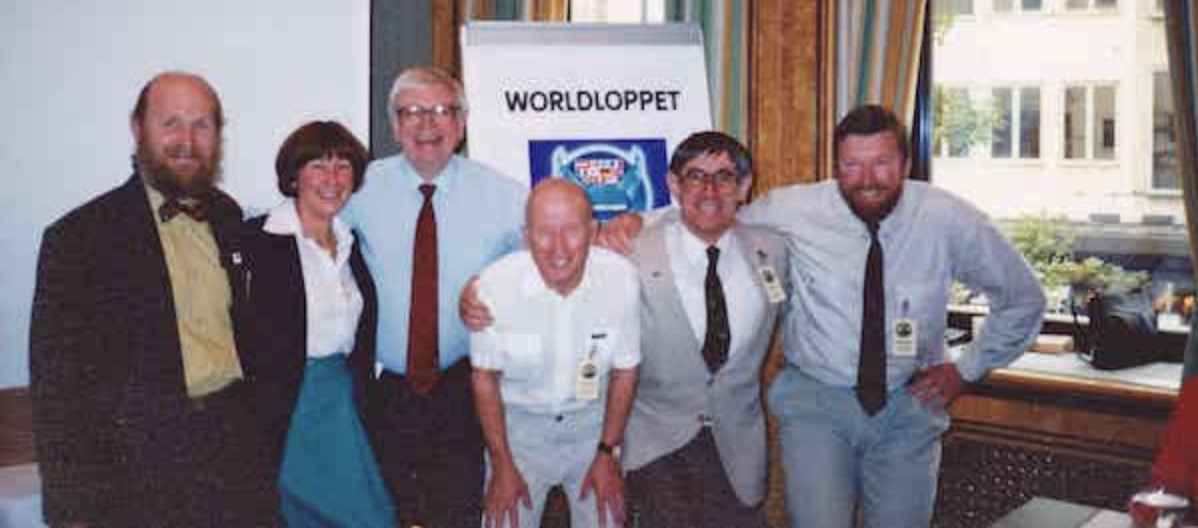Kangaroo Hoppet History
In the Beginning
In 1977 a group of cross country skiers in Mount Beauty, a small mountain valley town in north east Victoria, decided to form a cross country ski club. Some of them had skied in Norway and taken part in the Norewegian Birkebeiner Ski Race and thought that Birkebeiner would be a good name for their club.
Two years later, in 1979, the Birkebeiner Nordic Ski Club decided to hold their own version of the famous Birkebeiner race and the 21km Australian Birkebeiner was held with some 80 participants, all carrying a 5kg pack (the pack symbolised the weight of Prince Haakon part of the original Birkeberiner legend).
The course started and finished at the alpine ski village of Falls Creek, and took participants out into the wilderness area of the adjacent Bogong High Plains
The Club ran this event for ten years to 1988, and in early 1989, in a decision that seemed very simple at the time, it was decided that since they had the best ski race in Australia there was no reason why it should not become part of the Worldloppet series of marathon ski races that a small but growing number of Australians had travelled overseas to take part in.
Could a small local ski club conduct a 42km event? The easiest way to answer the question was to do it. In 1989 a 42km event named the Australian Birkebeiner Ski Marathon was held and the organisers also included a half distance of 21km called the Birkebeiner and a 7km event called the Birkebeiner Lite. The race was conducted in the classical style as that was the tradition of the original race in Norway and as adopted by Australia. Following the success of this event it was “all systems go” to work towards becoming a member of Worldloppet.
After a lot of communication, mainly by fax (remember those good old days before email) representatives from the Birkebeiner Nordic Ski Club and the Australian Ski Federation headed off to a Worldloppet Annual Meeting in Haamaliina (FIN) in June 1990 to put the case for a southern hemisphere race in the series. Their main task was convincing the assembled northern hemisphere folk that there really was snow in Australia.
The meeting decided that before being admitted the club had to demonstrate to Worldloppet that Australia could conduct a world class citizens cross country ski event. So another trial event had to be held. In 1990 The Australian International Ski Marathon with a half distance of 21km called the Australian Birkebeiner and a 7km race called the Birkebeiner Lite were conducted in late August. It was decided to change the style of skiing the event from the traditional classic to the free technique which meant skiers could use the classical style or the skating style or a combination.
The organisation, course layout, local infrastructure and participants were assessed by a delegation made up of Rolf Kjaernsli (NOR), Robert Steiner (AUT) and Tom Duffy (USA) and their report was discussed three months later at a special Worldloppet Meeting in Munich. The result was that Australia became the 12th member of Worldloppet but with one important proviso… a new name. Worldloppet already had two Birkebeiner events (Norway and USA) and two Ski Marathons (SUI and JAP). Australian Birkebeiner or Australian International Ski Marathon were definitely not on.

We Have Got It!
Worldloppet Meeting in Munich Germany in November 1990
From Let Allan Marsland (BNSC), Tourisim Vic lady & interpreter, Are Anderson SWE (Worldloppet Secretary – General, Rolf Kjaernsli NOR (spokesman fo rhe inspection team), Bob Lawton (Aust Ski Federation) and Peter Keage (alpine Resorts Commission)
What’s in a Name
The winter of 1991 was a year that all participants will never forget. It was the year the first Kangaroo Hoppet (42km) was conducted and we had not seen such heavy snow falls in over a decade. When a further metre of snow fell in 24 hours the event had to be postponed for one day as the trail groomers could not keep the course open.
The following day dawned with a cloudless sky and gentle breeze. The USA National Team were down-under for training and racing and the biggest field ever assembled for an Australian cross country ski race lined up in the starting area. The event was a huge success and the Kangaroo Hoppet, held at Falls Creek on the last Saturday in August became a regular fixture on the international ski calendar.
Features of the Event
In a country better known internationally for its natural environment – Uluru (Ayers Rock) and deserts, coral reefs, tropical rain forests, together with the wildlife – kangaroos, koalas, penguins and the incredible egg laying mammals the platypus and echidna; the idea of snowfields and ski racing in Australia seems quite surreal.
That Australia is a land of contrasts is quickly made apparent to northern hemisphere skiers who arrive in Melbourne. After leaving the vibrant state capital of Melbourne with its combination of magnificent gardens, big city shopping restaurants and theatres, the would be Hoppet skier travels through open farmlands and the world famous vineyards and wineries of the Milawa and Alpine Valleys wine regions to the town of Mount Beauty, nestled at the foot of the mountains. While in Mount Beauty there is blossom on the plum trees, oranges and lemons on the tree and daffodils in the gardens, just a short 30km drive through tall eucalypt forest and an increase in altitude of 1200 metres brings them to the alpine village of Falls Creek, nestled in a sheltered valley on the edge of the snow covered plateau of the Alpine National Park (altitude 1,600 metres).
Last, but by no means least, of the features of the Hoppet is the friendly and relaxed approach to life of the Australian. Australians also love to participate in sport, and the Kangaroo Hoppet caters for this passion by offering not only the main 42km and the 21km event, but also a 7km event that attracts a diverse group of skiers, ranging from elite juniors to parents, grandparents, babies in pulkes and first time skiers.
Significance of Worldloppet Membership
The Kangaroo Hoppet as a member of Wordloppet brings the Australian snowfields to an international audience, many of whom had no idea that there was snow in Australia, a land better known for deserts, coral reefs, surf beaches, koalas, kangaroos and penguins.
A Worldloppet event in Australia creates a special opportunity for northern hemisphere skiers to indulge in their passion for skiing in the middle of the northern summer, and to combine it with an extended holiday to explore the range of experiences offered across the diverse Australian environment. Each year skiers from over twenty nations make the trip to the other side of the world to take part in the Hoppet.
The reverse is also true, Worldloppet introduces Australian citizen skiers to the fun of international skiing and increasing numbers of Australians are taking up the challenge and travelling regularly across the world to become a part of Worldloppet with the eventual goal of becoming a Worldloppet Master. Watch out for one at a Worldloppet event near you.




